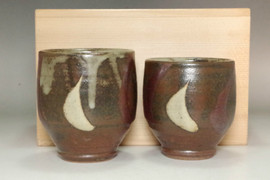Matsuzaki Ken (1950- ) Vintage mashiko pottery tea cup #4508
- SKU:
- 4508
- Shipping:
- Free Shipping
- width: approx. 7cm (2 3⁄4in)
- tall: approx. 7.5cm (2 61⁄64in)
- weight: 153g
Matsuzaki Ken (1950- )
From Machida, Tokyo. Father was a Japanese-style painter. Eldest brother was a woodworking artist. Graduated from the Faculty of Ceramics at Tamagawa University. Studied under Shimaoka Tatsuzo before starting a kiln in Sayado in 1977 and becoming independent. Is a Fellow Member of the Kokuten Exhibition and won the Nojima Award. Held a parent and children exhibition with his father and older brother at the Ginka in Akasaka. Held master and pupil exhibitions with Shimaoka Tatsuzo around the country. Held private exhibitions at the Keio in Shinjuku, the Hankyu in Osaka, the Takashimaya in Yokohama, and other venues. Works focus on Tsutsugaki resist-dyeing with Shirokesho white slip-coating, Kakiotoshi designs, and Hakeme brush strokes.
Mashiko ware
It is generally agreed upon that Mashiko ware originated towards the end of the Edo period, in the year 1853 (Kaei 6). It was then that Keisaburo Otsuka, having learned the art of pottery in the city of Kasama, Ibaraki, traveled from what is now the town of Motegi, Tochigi to the town of Mashiko, where he discovered potter's clay and first lit his kiln.
The pottery industry continued to develop through the Meiji period, taking advantage of the bounties of the land to achieve Kanto-wide distribution of its wares. Around the same time, teapots decorated with simple landscape paintings were first created, and would go on to be produced in great numbers. Those teapots would later receive high praise from Hamada Shoji. However, towards the end of the Meiji period, as Tokyo (a major consumer of wares) modernized, the lifestyles of its residents began to change. This, combined with the rise of high-quality Kyo ware and the proliferation of rival Kasama ware, had a significant impact on Mashiko ware. This marked the beginning of a dark age for Mashiko.
After the Great Kanto Earthquake of 1923 (Taisho 12) struck Tokyo, Mashiko, which had been on the decline, received a new lease on life, thanks to the favorable economic conditions brought about by the earthquake. In the following year, Hamada Shoji, a master of the folk-art movement, established a pottery studio in Mashiko.
Awareness of Mashiko ware spread in concert with Hamada Shoji's fame. Finally, in 1955 (Showa 30), Hamada accepted a designation as a Living National Treasure for his exploits in the realm of folk pottery. Mashiko ware became known worldwide, and so the town of Mashiko came to achieve its current status and popularity among the general public.
The Mingei Movement
The Mingei (folk-art) movement was initiated by Yanagi Soetsu, Kawai Kanjiro, and Hamada Shoji in 1926 (Taisho 15) as an approbation of functional craftwork used by the masses in the course of daily life. At the time, the craft world was dominated by decorative pieces prized for their aesthetic value. In response, Yanagi and cohorts promoted the quotidian lifestyle implements handmade by anonymous craftsmen as mingei (“craft of the common folk”), arguing that such works have a beauty that rivals fine art, for beauty can be found in the everyday. A further pillar of the movement introduced a “new way of looking at beauty” and “aesthetic values” via the notion that crafts born from the local practices and rooted in the rhythms of the rural regions of Japan embody a utilitarian, “healthy beauty.” Their ideology was, in many ways, related to the era, marked as it was by the advance of industrialization and tandem gradual influx of mass produced products into the sanctum of daily life. Troubled by the loss of “handicraft” across Japan, the Mingei movement warned against the easy progression of modernization/Westernization. In this way, the Mingei movement served as a vehicle for the artists to pursue the question of what constituted a good life, rather than simply a life rich in material wealth.
















